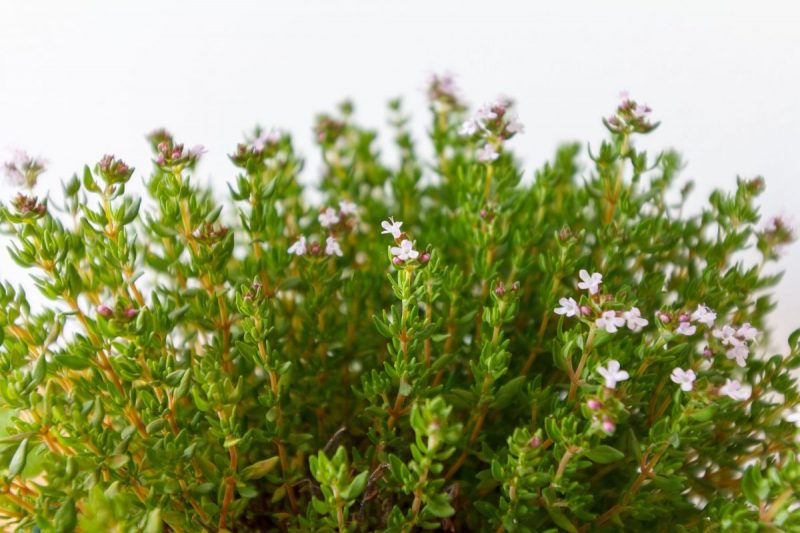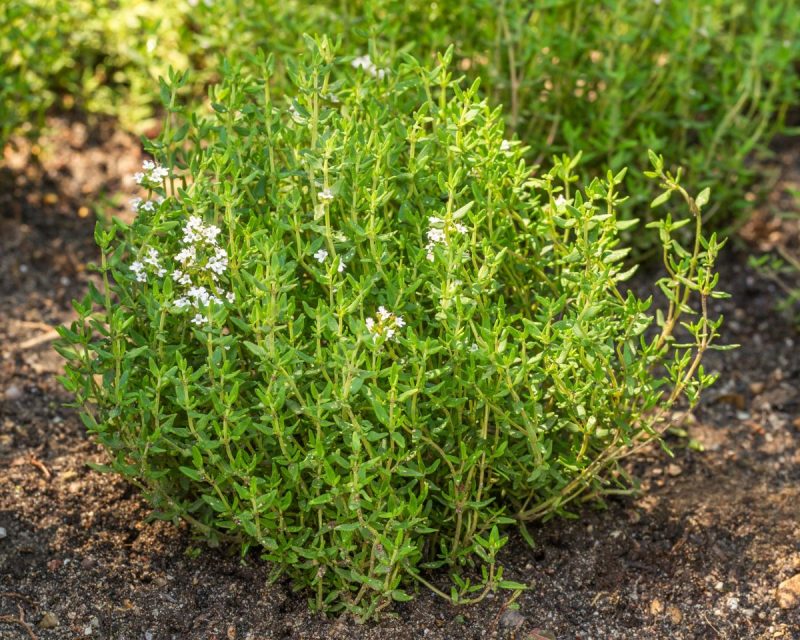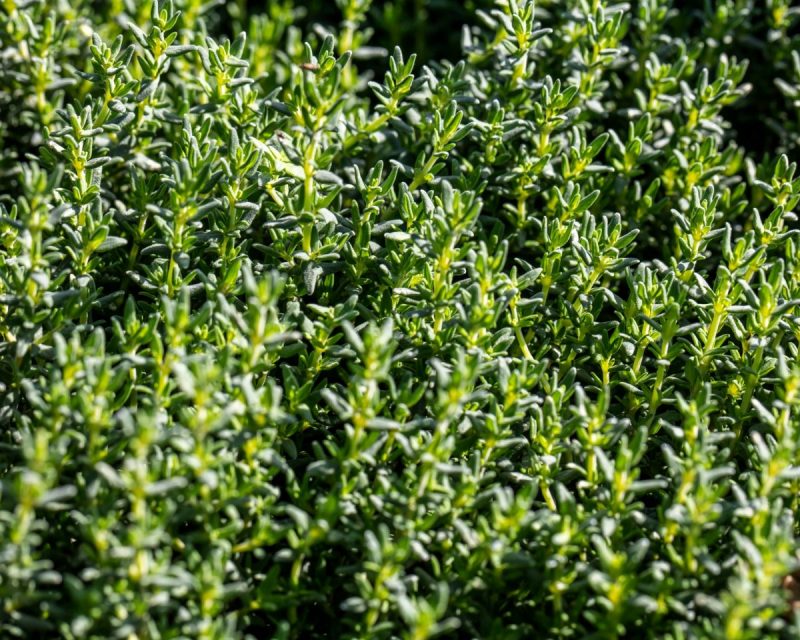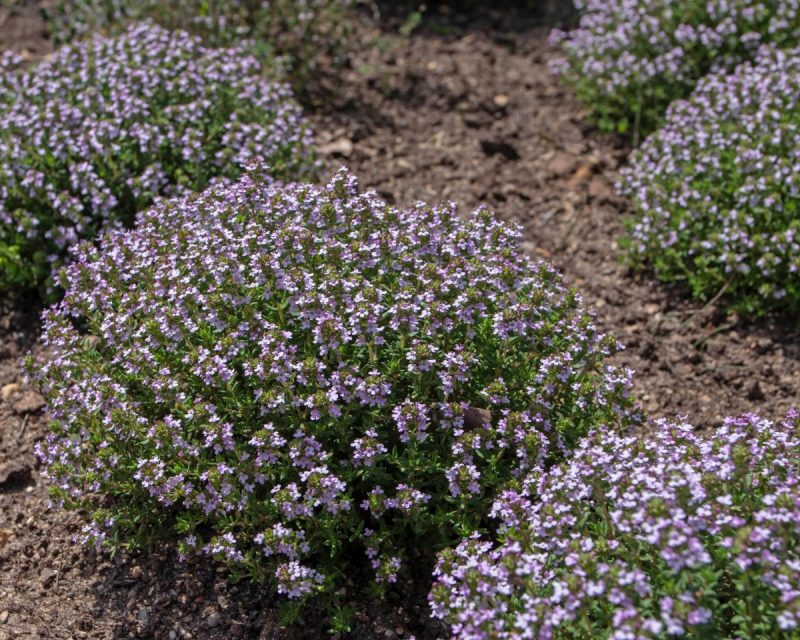Thyme – planting, growing and harvesting

Thyme (Thymus vulgaris) is a plant native to southern Europe, from where it has spread around the globe. It is still found today in the spontaneous flora of the Mediterranean countries and even in Siberia, being common in the hilly regions. Thyme has been known since antiquity, at first, it was used as a medicinal plan. Nowadays it is commonly grown in vegetable gardens in many countries as a spice and medicinal plant.
The leaves and the underside of the young shoots are used to flavor and season various foods. The whole plant contains essential oils, which in the aerial part of the plant reach a concentration of up to 2.5%, and in seeds up to 6%.
Botanical characteristics
Thyme is a perennial plant, which comes in the form of a sub-shrub. In the first year of vegetative growth, it has a pivot root, 20 cm long, woody, branched, with the main part developed in the fertile layer from the soil surface. The stem is abundantly branched, with four-edged branches, pubescent, lignified on the underside. The leaves are very short, petiolate, oppositely arranged, with an elongated rhomboidal, lanceolate, or ovate foliar limb. The flowers are small, hermaphroditic, pink, very fragrant.



Environmental requirements
It is a rustic plant, with low demands in terms of soil and environmental conditions. In terms of heat, the demands are different, depending on the cultivated variety. The summer thyme is sensitive to cold and in culture, it is treated as an annual plant. The winter thyme, being more resistant to cold, behaves like a perennial plant and can remain in culture for 5-6 years. It is a light-loving plant. The young plants do not tolerate shade and therefore, the culture must be set up in sunny fields, with southern exposure.
Humidity requirements are relatively low since it tolerates periods of drought well. It develops well in light and medium soils, rich in humus, permeable, with underground water at greater depths.
Cultivation
It is done by sowing directly in the field, by planting seedlings, or by separating old bushes from poorly productive crops. Sowing directly in the field or removing the bushes should be done in late autumn. Spring sowing is not recommended, because the seed is very small, the surface layer of the soil dries quickly and the plants do not always grow, so it will be necessary to reseed.
In the case of seedlings, they are sown in March or July, at a distance of 12-15 cm between rows. Planting seedlings in the field should be done in July. They can be planted manually or mechanized, three rows on each high soil layer, at 18-19 cm between plants per row.
In the vegetable garden, thyme is grown in the plot reserved for perennial plants or as a border plant.
Care
Because the plants grow very slowly, especially in the case of crops obtained by sowing directly in the field, the care works in the first year have to be very thorough. In the early spring, work on the intervals between rows so that the soil does not dry out. In the first year of vegetation in crops established by direct sowing in the field, the plants are thinned out when they have 4-5 pairs of leaves, about 18-19 cm apart.
In the case of plants grown in flowerpots or in the garden, to ensure their nutrient requirements, a specially formulated fertilizer can be administered regularly.
Recommended products
-
You can find products on a different store
Change Store -
You can find products on a different store
Change Store -
You can find products on a different store
Change Store -
You can find products on a different store
Change Store -
You can find products on a different store
Change Store -
You can find products on a different store
Change Store -
You can find products on a different store
Change Store -
You can find products on a different store
Change Store -
You can find products on a different store
Change Store -
You can find products on a different store
Change Store -
You can find products on a different store
Change Store -
You can find products on a different store
Change Store -
You can find products on a different store
Change Store -
You can find products on a different store
Change Store -
You can find products on a different store
Change Store -
You can find products on a different store
Change Store -
You can find products on a different store
Change Store -
You can find products on a different store
Change Store -
You can find products on a different store
Change Store -
You can find products on a different store
Change Store -
You can find products on a different store
Change Store -
You can find products on a different store
Change Store -
You can find products on a different store
Change Store -
You can find products on a different store
Change Store
Harvesting
It consists in cutting the young branches, at a height of 10-15 cm from the ground, without cutting the wooden part. This should be done in sunny weather after the dew has lifted. The culture can be harvested even in the first year so that the plants are fortified at the beginning of winter.















































































































































































































































































































































































































































